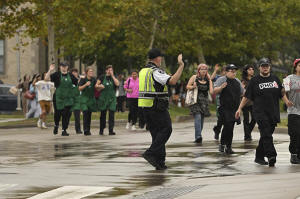Spate of hoax calls about active shooters stir fear at college campuses
around the US
[August 27, 2025]
By ANDREW DeMILLO and HEATHER HOLLINGSWORTH
Miceala Morano scrambled for cover behind a green screen in the
University of Arkansas broadcast room after she received a campuswide
alert about an active shooter.
As officers outside donned bullet proof vests and searched for an
intruder, the 21-year-old journalism student called her grandmother,
telling her, “As of right now, I’m safe. I love you."
Monday's threat turned out to be part of a rash of hoax calls about
active shooters on college campuses — some featuring gunshots sounding
in the background — that have sent waves of fear among students around
the nation as the school year begins.
The calls prompted universities to issue texts to “run, hide, fight.”
Students and teachers rushed for cover, often cowering in classrooms and
under desks for safety. Officers swarmed over campuses, seeking out any
threat.
That the threats turned out to be false doesn't much matter in the
moment for terrified students.
“There’s just these few minutes where all you really feel is fear,
whether the threat’s there or not,” said Morano, whose childhood active
shooter drills taught her to stack chairs blocking the classroom door
and to climb into the ceiling as a last resort.
The hoaxes and false alarms have hit at least a dozen college campuses.

On Monday alone, law enforcement responded to calls claiming active
shooters at Arkansas, Northern Arizona University, Iowa State, Kansas
State, the University of Colorado-Boulder and the University of New
Hampshire. More calls were made Tuesday at the University of Kentucky,
West Virginia University and Central Georgia Technical College.
Latest wave of swatting calls began in Pennsylvania, Tennessee
At Villanova University, students were attending Thursday's Orientation
Mass when law enforcement received multiple calls about a man opening
fire on campus with an AR-15 style weapon. Sounds of gunfire could be
heard in the background of the calls.
Chairs banged together and bags dropped as students fled, recalled Ryan
Scanlon, who was in eighth grade at a neighboring school when the mass
shooting occurred at Marjory Stoneman Douglas High School in Parkland,
Florida, in 2018.
Now a Villanova senior, he joined others sheltering in the school
library, waiting with little news for about an hour before police
arrived to clear out buildings.
“It’s really not funny,” Scanlon said. “If you experience that real
thing, you never know what can happen next.”
Hours earlier, Tennessee authorities received similar false calls
reporting an active shooter with an AR-15 style rifle at the University
of Tennessee at Chattanooga and four persons shot. Dispatchers reported
hearing multiple gunshots on the calls.
“This incident was a criminal act, intended to be disruptive and cause
chaos,” the school said in a statement.
The University of South Carolina also received two calls Sunday
reporting an active shooter at the school’s library, with the sound of
gunshots in the background.
South Carolina Gov. Henry McMaster said authorities must find whoever
was behind the calls, comparing them to yelling fire in a crowded
theater.
“It could have been a lot worse than it was. Maybe next time it will be
worse,” McMaster told reporters.
Swatting causes terror
The goal of swatting is to get authorities, particularly a SWAT team, to
respond to an address.
In an era of mass shootings, the calls create a climate of fear, sap law
enforcement resources and can lead to deadly mistakes. In 2017, for
instance, a police officer in Wichita, Kansas, shot and killed a man
while responding to a hoax emergency call.
[to top of second column]
|

University of Arkansas students and employees evacuate and take
shelter Monday, Aug. 25, 2025, in Fayetteville, Ark., as police
respond to reports of a shooting. (AP Photo/Michael Woods)

The FBI provided no information about a motive, but said Tuesday
that it was working with law enforcement on the swatting cases on
college campuses, which come as such false reports surge nationwide.
A wave of threats three years ago was believed to have come from
outside the country, the FBI said at the time. The agency provided
few details about the recent campus threats, including whether they
are coordinated, but the calls appear to share similar traits.
Most involved multiple calls about an active shooter or shooting,
and at least four included the sound of gunshots in the background.
Fred Posner, a telephoning consultant at LOD.com, said advances in
technology have made it easier for people making such swatting calls
to conceal their identities. Posner said law enforcement also faces
the challenge of how easy phone carriers have made it for people to
obtain a number.
“The only way for this to stop is to have some sort of enforcement
and crackdown against the carriers that continually allow this to
occur,” Posner said.
Experts fear hoaxes may make students dismiss warnings
The worry is that hoaxes will create complacency at campuses where
active shooter alerts and drills have become a regular part of life.
“We live in tornado alley where people go hear a tornado warning and
go outside to look,” said Mya Norman, a chemistry instructor at
Arkansas who hid trembling under her desk as the Fayetteville campus
remained on lockdown. “So it does concern me that we could end up
with that kind of an effect.”
Ken Trump, president of National School Safety and Security
Services, said campus officials face a “delicate balance” in keeping
students and teachers on guard, but not panicked, for any real
threats in the future.

For many, he said, panic lingers weeks and even months after the
hoaxes.
Norman is still haunted by what happened. As she tried to reassure
her son and husband, her thoughts raced. “It’s kind of rotten but in
some ways I thought well it’s our turn,” she said.
Casey Mann, a 19-year-old who joined Morano in hiding behind a green
screen, said she couldn’t sleep until 2 a.m. after the Arkansas
lockdown.
“It’s just a scary reality the time we’re living in right now,” she
said, her voice choking up. “It just makes me wonder what we’re
supposed to expect in the future.”
___
DeMillo reported from Little Rock, Arkansas, and Hollingsworth
reported from Mission, Kansas. Associated Press Writers Kate
Brumback in Atlanta; Jack Dura in Bismarck, North Dakota; Michael
Casey in Boston; Matthew Brown in Billings, Montana; Kristin Hall in
Nashville and Jeffrey Collins in Columbia, South Carolina,
contributed to this report.
All contents © copyright 2025 Associated Press. All rights reserved |